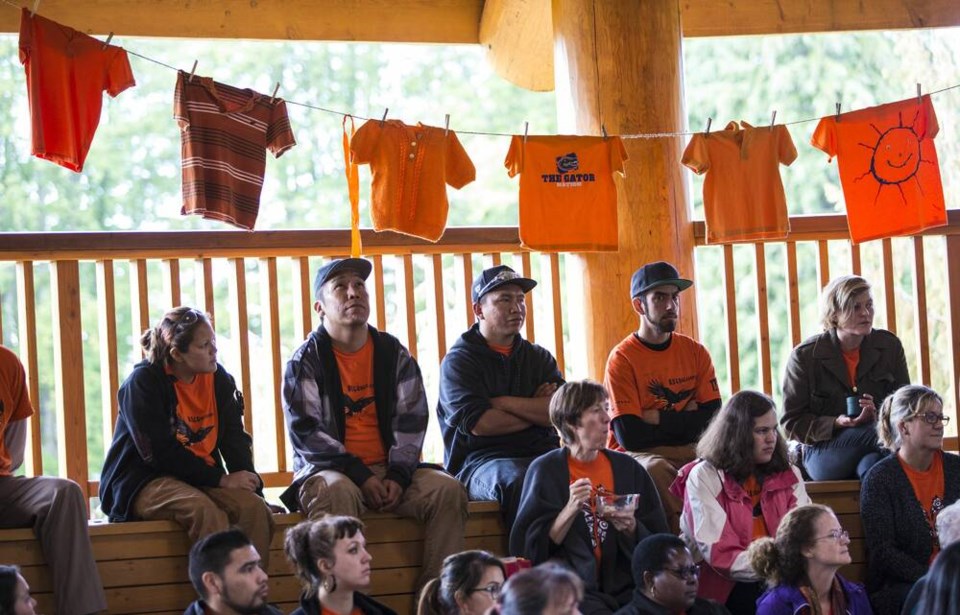The Canadian government has designated Sept. 30 as a National Day for Truth and Reconciliation and made it a federal statutory holiday. The British Columbia government has followed suit, with schools closing for the day as well as some other public sector workplaces.
This day deserves commemoration.
Those of settler heritage, including myself, can take advantage of this opportunity to listen, learn and discern how to take actions to decolonize ourselves and the First Nations lands upon which we live.
As we reflect upon the past, we need to remember that this commemorative day emanated not from the government but from the Truth and Reconciliation Commission (TRC) as part of its 94 Calls to Action.
It emanated from the incessant struggle by the survivors of residential schools for justice that led to the creation of the TRC.
And it emanated from the revelations this summer regarding the confirmation of hundreds of unmarked graves in the grounds of residential schools, a tragedy well-known among Indigenous communities.
Thus, Sept. 30 is also Orange Shirt Day, a commemoration initiated by Phyllis Webstad, a Northern Secwpemc (Shuswap) from the Stswecem’c Xgat’tem First Nation, to symbolize how residential school, which seized her orange shirt when she was first sent to school, had stolen Indigenous culture.
The words of Simon Fraser University professor June Francis come to mind: “We need our white brothers and sisters to really own this because it is a problem of white supremacy — of putting one group and their needs at [the] centre of [a] system that has worked only because it has dominated others.”
Her statement, made during the height of the Black Lives Matter movement last year, applies to this day and every day so that we can stand in solidarity with First Nations. If we care to look around us, we see ordinary folks engaging in extraordinary acts of decolonization.
In Victoria, senior Marion Cumming has willed her home in Oak Bay, worth more than $2.2 million, to the Victoria Native Friendship Centre in the name of reconciliation.
At the University of British Columbia, Dr. Tara Martin knew that SISȻENEM (Halibut Island) was an “ecological and cultural jewel” in the Gulf Islands that deserved to be returned to the W̱SÁNEĆ nation, so she brought together funders and the Land Conservancy of B.C. to buy the island and turn title over to the W̱SÁNEĆ Leadership Council.
Many others are engaging in everyday acts of decolonization by supporting Indigenous struggles, be it at Fairy Creek to halt old-growth logging, with the Wet’suwet’en to stop the Coastal GasLink pipeline, or with the many Nations fighting the Trans Mountain pipeline.
Emilee Gilpin, the managing editor of IndigiNews, began the week by pointing out how “reconciliation” seems like a strange term to many people in Indigenous communities: “As an 11-year-old Haida boy recently told me: ‘What did Indigenous people do wrong’?”
This is a message that I have also been getting.
On a trip to Bella Bella this summer, my partner and I were gifted with T-shirts made by the Heiltsuk nation. The T-shirts are emblazoned with the term Haíɫcístut. This is their preferred term regarding what needs to happen we were told, and it means “To turn things around, and make things right again.” Asked whether the term had the connotation of “starting over,” our hosts responded that it did contain that meaning as well.
I asked the question because earlier in the year I had listened to a webinar on environmental racism sponsored by the Canadian Association of Physicians for the Environment featuring Molly Wickham (Sleydo) and Elder Francois Paulette.
Paulette, a member of the Smith’s Landing First Nation (Treaty 8), revered protector of the land, and recipient of the Order of Canada, expressed his frustration with the term: “Reconciliation, wow, reconciliation what a fancy big word. But those guys — just a word, a talk. In my language when we do harm to somebody, and we make amends, we say, we say Nunal ye. What that means is, ‘Let’s take down, let’s take down and start over.’ So, if Canada is talking about reconciliation, based on that, rather than their words of reconciling, then we have somewhere to go boy — but now it’s all about them.”
“We’re not the ones, we don’t have to reconcile with Canada, what harm have we done them. I try to figure that one out — what harm have we done to Canada?”
Reconciliation has indeed become a loaded term. As we search for alternatives, particularly among Indigenous languages that are being brought back to life, we can still learn from the Truth and Reconciliation Final Report:
“Together, Canadians must do more than just talk about reconciliation; we must learn how to practise reconciliation in our everyday lives — within ourselves and our families, and in our communities, governments, places of worship, schools, and work- places. To do so constructively, Canadians must remain committed to the ongoing work of establishing and maintaining respectful relationships.”
Building such respectful relationships will depend on successfully returning the land to its rightful owners.
John Price is professor emeritus at the University of Victoria and co-author with Nicholas XEMŦOLTW̱ Claxton, Denise Fong, Fran Morrison, Christine O’Bonsawin, Maryka Omatsu, and Sharanjit Kaur Sandhra, of Challenging Racist “British Columbia”: 150 Years and Counting, available as a free download at challengeracistbc.ca.



